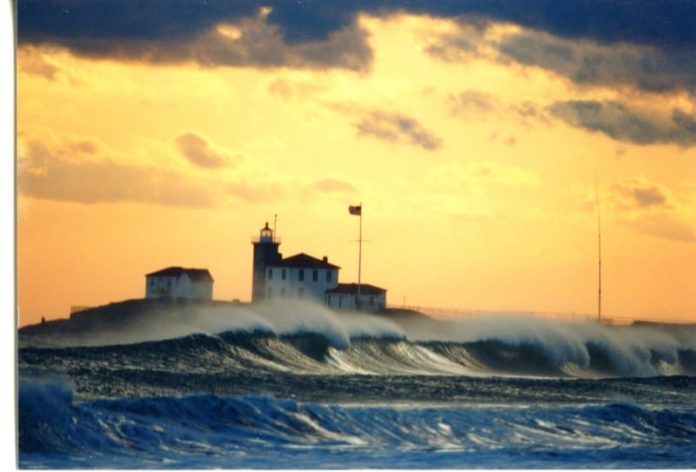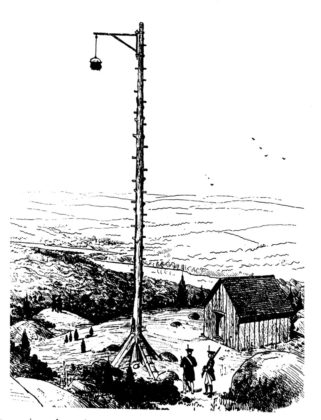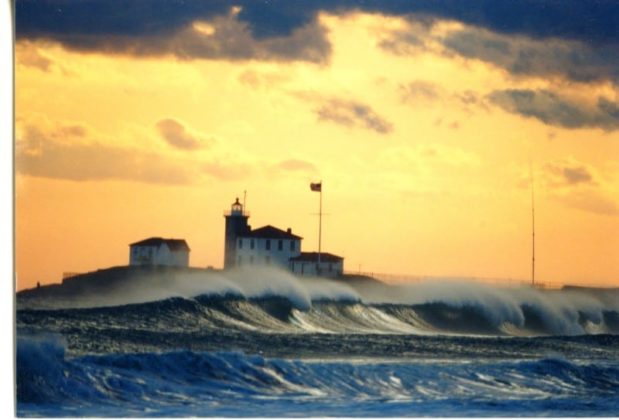Watch Hill Lighthouse
People have always been fascinated by lighthouses, the romantic castles of the sea. Built on sea sprayed rocks or windswept bluffs, they are stations of duty. With shining beacons in the pitch dark night, they warned mariners in the nick of time before their impending doom. This story is the first in a short series about some of the most iconic lighthouses along the Rhode Island and Connecticut coasts.
It is said that the first people to use Watch Hill as a lookout were the Niantic Indians. Later, in the mid-1700s, the Rhode Island colonial government erected a watchtower and beacon during the French and Indian War. This consisted of a tall wooden pole with a crossbar at the top holding a bucket of pitch or oakum. When lit a fire could be seen at night and smoke during the day. A series of these poles were erected along the Rhode Island coast. The beacon was destroyed in a 1781 storm.
Because of the large number of shipwrecks plans were discussed to build a new lighthouse to mark the eastern entrance to Fishers Island Sound and to warn mariners of a dangerous reef southwest of Watch Hill. President Thomas Jefferson signed an act to build the lighthouse in 1806 and construction was completed in 1807. This first Watch Hill lighthouse was a thirty-five-foot-tall wood-framed tower. There was also a five-room frame house for the keeper’s accommodation.
As the first lighthouse was being constructed, Secretary of the Treasury, Albert Gallatin wrote a letter to the superintendent of lights for the state of Rhode Island asking that Jonathan Nash of Westerly be appointed keeper of the new light. Nash recorded 45 wrecks during his 27 years of service from 1808 to 1834. Lighthouses must also inspire romance as Nash fathered 10 children while doing his keeping.
By the 1850’s the wooden lighthouse and keeper’s cottage were rotting. The frequent storms had eroded the surrounding land and the tower was in danger of falling over. In 1856 the second and what is now the present-day lighthouse was built from gray Westerly granite and a brick keeper’s cottage was also constructed.
Lighthouse keepers at this time were poorly paid and to supplement their incomes many early lighthouse keepers rented out rooms. Jonathan Nash took in boarders to supplement his meager salary of $200 a year but the government frowned on this and he was forced to stop the practice. Nash lost his job in 1834 but boarding lodgers must have paid well because over time he was able to acquire 61 acres of land in Watch Hill and built the first of Watch Hill’s large hotels.
In 1872 the steamer Metis crashed off Watch Hill killing 67 people. A United States Life-Saving Service station was built next to the lighthouse where it operated until the 1940s, it was destroyed in 1963.
The lighthouse was automated in 1986 and is leased to the Watch Hill Lighthouse Keepers Association. It’s a great place to view the ocean and Fido will love the grassy field for a romp. A small museum is open in the summer months Tuesday, Wednesday, and Thursday afternoons from 1 to 3 p.m. The private road down to the lighthouse is open to senior citizens and the disabled, all others must park in the village and walk down.














